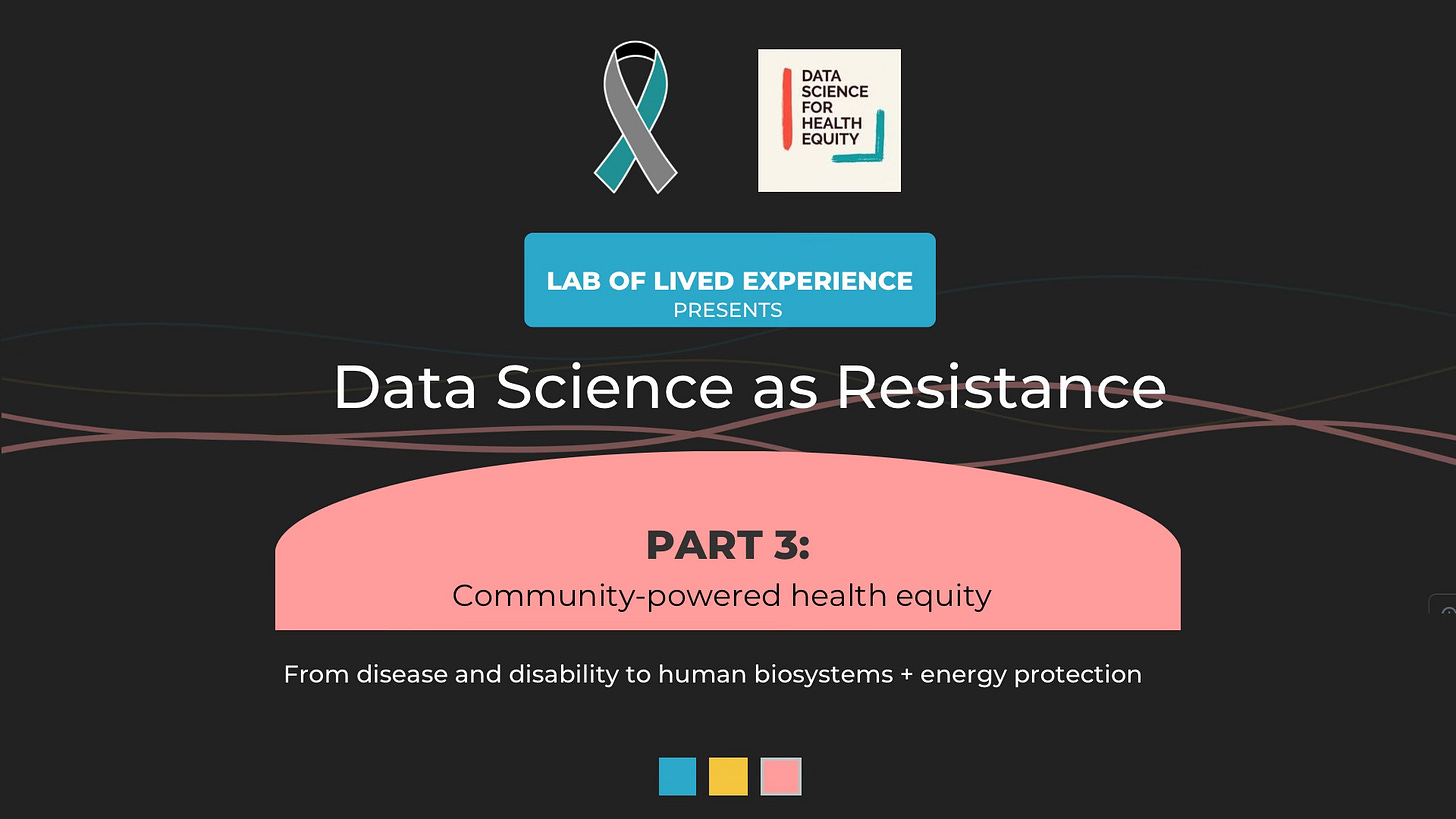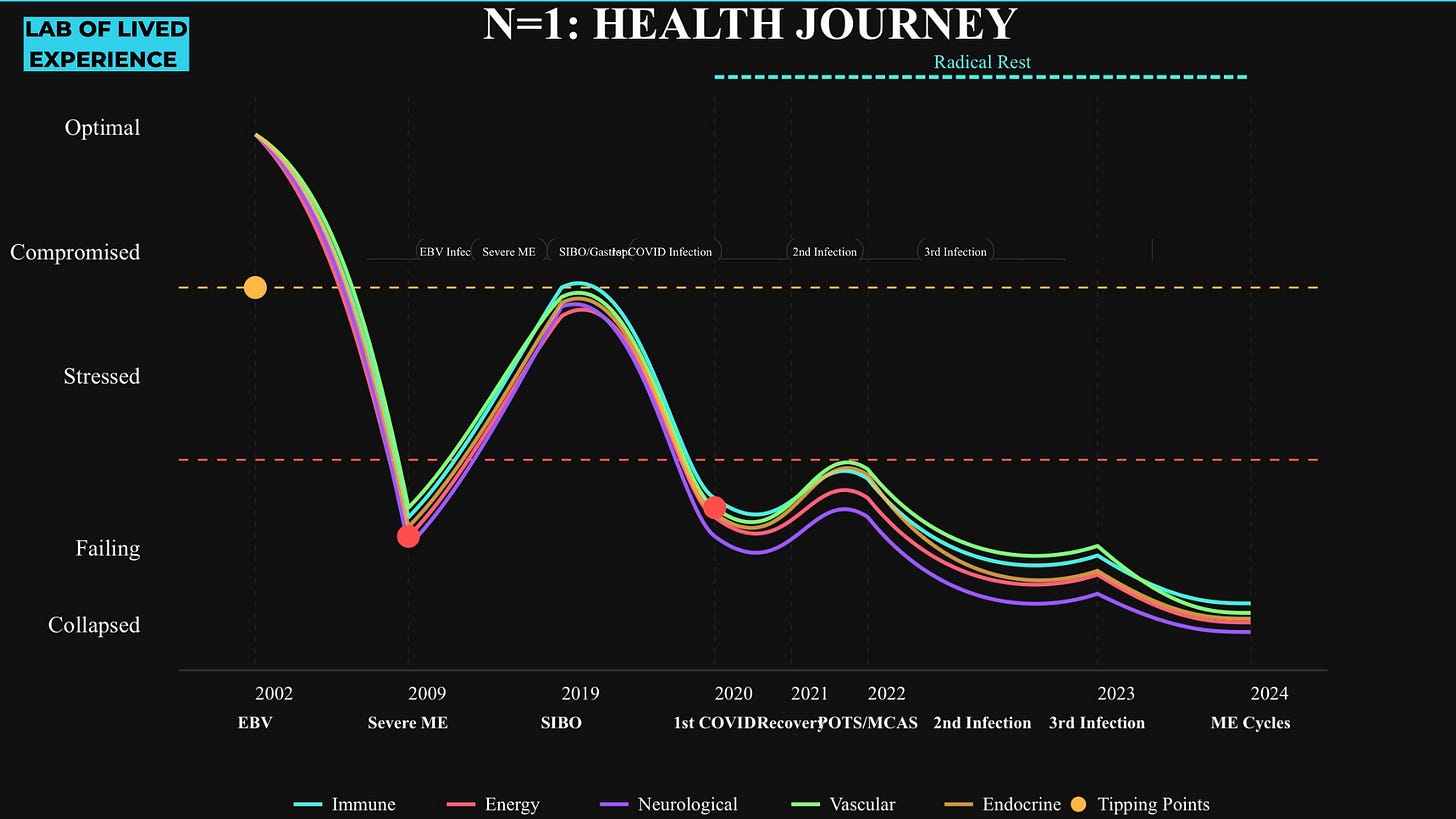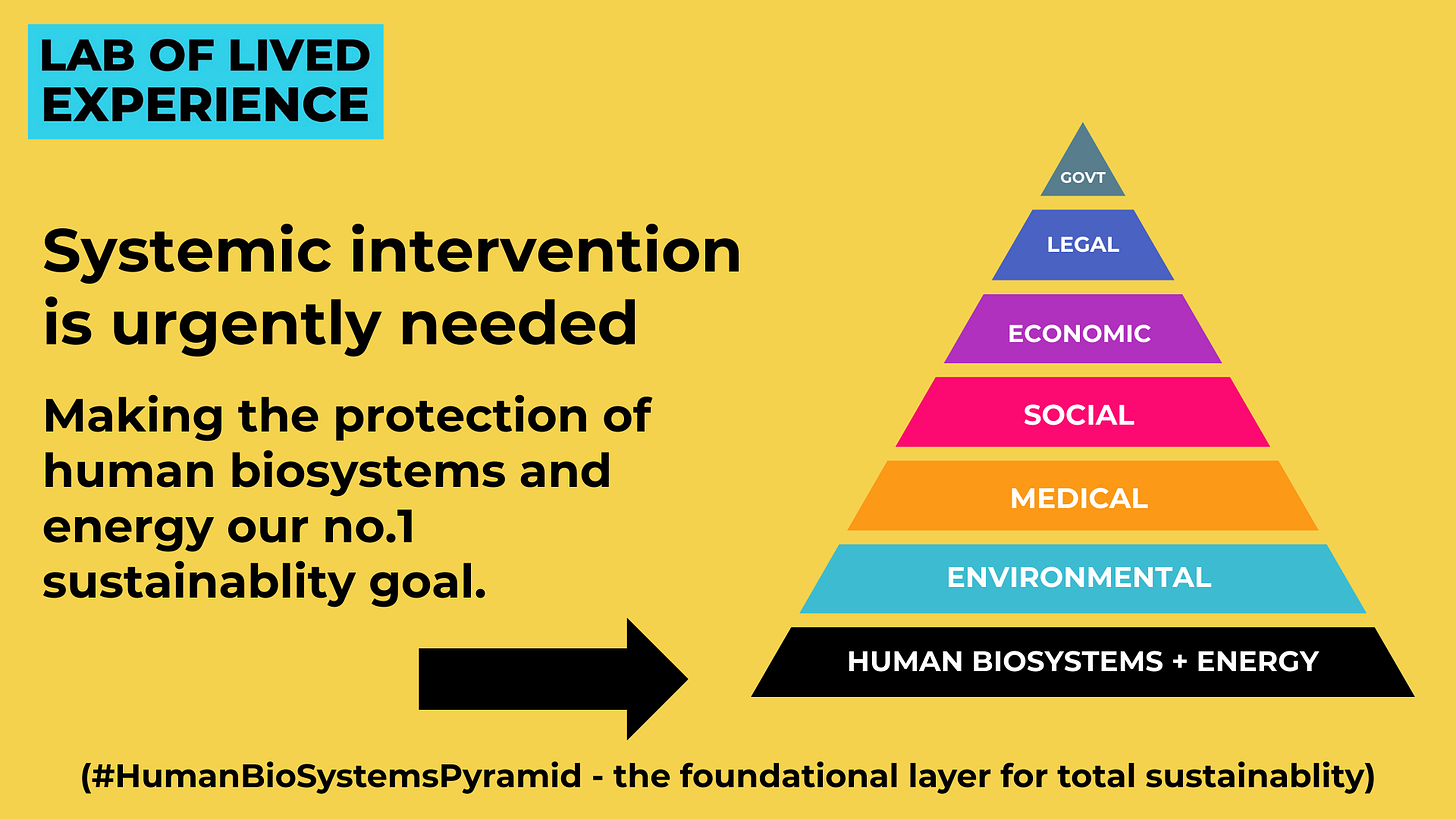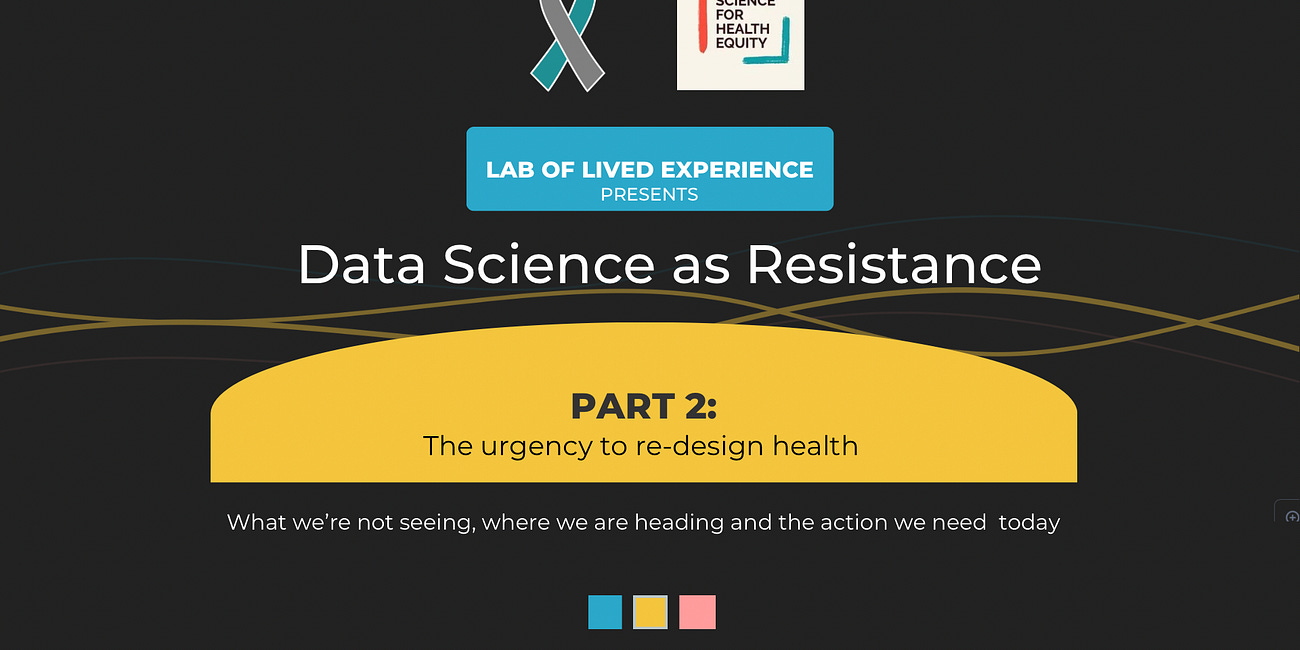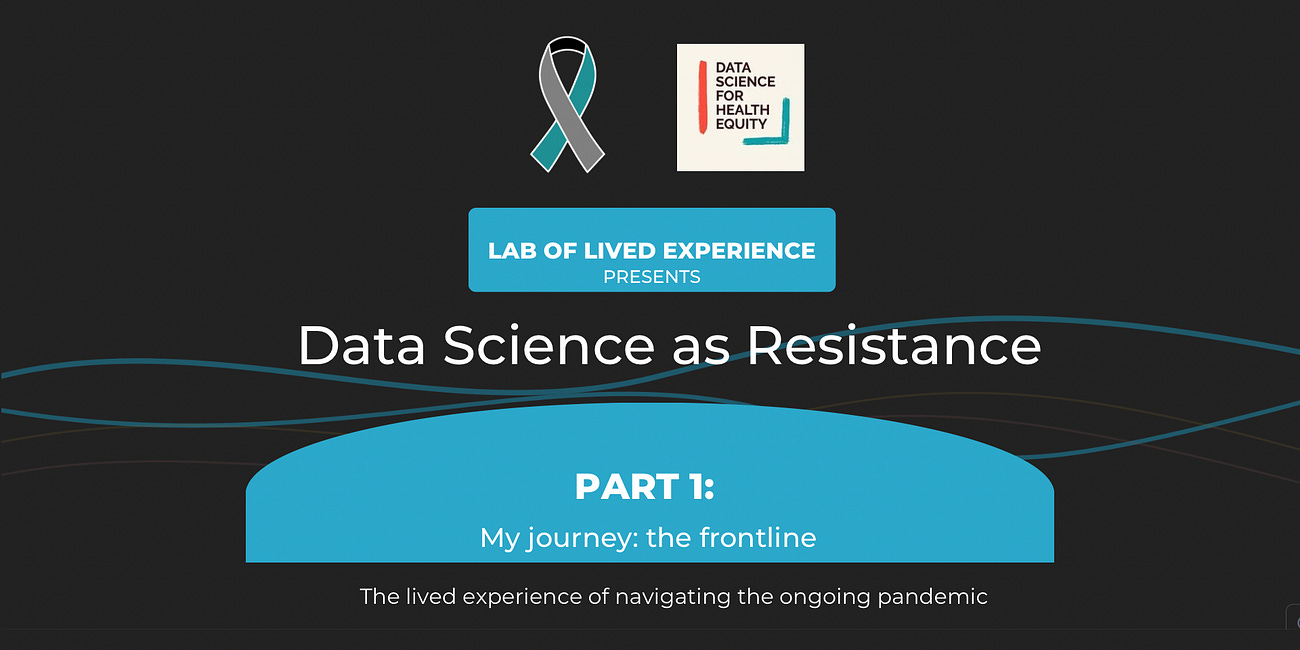Data Science as Resistance: Community-Powered Health Equity
Part 3: Energy-Aware Design and Human BioSustainability
The Failure of Current Models for Energy-Limiting Conditions
Today's disability frameworks are failing those with severe energy-limiting conditions (ELC)12 The social model of disability—while revolutionary for many conditions—becomes actively harmful when weaponised in "back to work" policies that falsely assume all barriers are external and can be accommodated away.
For those with profound energy limitations and Post-Exertional Malaise (PEM)3, the biological reality is that work itself can cause severe symptom exacerbation and deterioration4. Most frameworks for chronic illness5 primarily serve those with mild to moderate conditions, while setting dangerous expectations for the severely affected.
Recent UK policy developments underscore the urgency of this issue. The 2025 cuts to Personal Independence Payments (PIP), projected to strip £5bn from disability benefits, have sparked rebellion even among government MPs, whilst Labour admits not knowing the impact6 yet refusing to engage the people they are meant for7. These cuts disproportionately impact those with energy-limiting conditions who already struggle to access appropriate support8.
For those with profound energy limitations, a sustainability approach recognises biological realities that align with Kate Raworth's Doughnut Economics model, which establishes both a social foundation and an ecological ceiling. Similarly, human energy requires both a protective floor and regenerative boundaries.
Beware of Harmful Corporate "Solutions" and Historical Stigmatisation
Key organisations in the inclusive work and disability rights movement have shown a notable lack of allyship with Long COVID and ME disease communities precisely because acknowledging these conditions would require confronting the limitations of the social model they have fought to establish.
As a direct result, a concerning trend is emerging as companies attempt to address energy-limiting conditions in the workplace through outdated and potentially harmful mental health and rehab approaches, including Graded Exercise Therapy (GET) and Cognitive Behavioral Therapy (CBT) as primary "treatments" for conditions like ME and Long COVID, despite contradicting the 2022 NICE guidelines and latest research debunking ‘deconditioning’ theories9.
We've been here before with government-sponsored clinical trials like PACE that stigmatised ME patients and falsely promoted exercise therapy as a cure10, leading to decades of harmful policies, medical gaslighting and frequent deaths and suicide11.
Insurance companies are following a similar playbook. In Switzerland, the majority of Long COVID insurance claims are being rejected12, mirroring practices seen with ME for decades. These rejections often rely on outdated psychological frameworks rather than recognising the measurable biological dysfunctions that characterise these conditions. By classifying these conditions as primarily psychological, insurers can minimise payouts while maximising patient blame—a profitable but deeply immoral approach.
This pattern is particularly evident in how employee burnout is routinely psychologicalised, especially for women—perpetuating the cycle of "hysteria" and medical misogyny13. Rather than recognising the biological impacts of excessive workloads and toxic environments, the focus remains on individual mental resilience, mindfulness, and purpose alignment for happiness at work.
Energy-Aware Design: A Revolution in Participation
Last year, I launched an online experiment with a small group of severe ME and Long COVID patients to capture the value of our lived experience through bite-size creative tasks with no meetings and built-in rest days as a core principle of 'energy-aware' design.
Energy-aware design has emerged from the fundamental challenge of fluctuating capacity that characterises these conditions. Unlike disabilities with relatively stable limitations, ME and Long COVID involve day-to-day and even hour-to-hour variations in cognitive, physical, and emotional capacity.
Energy-aware design principles include:
Cognitive pacing: Breaking complex tasks into small, discrete units that can be completed in short bursts
Built-in recovery periods: Scheduling mandatory rest days between activities
Flexibility in timing: Allowing participants to contribute when their energy permits
Multiple contribution pathways: Creating various ways to participate based on different types of capacity
Energy budget transparency: Making the estimated energy cost of activities clear upfront
This approach goes beyond accommodations to reimagine human sustainability in collaborative work and challenges the idea that people who can’t do a job are “economically inactive”. By designing around energy conservation and fluctuating capacity as core principles, we're pioneering AI-assisted advocacy methodologies that protect biological reserves rather than depleting them and highlighting their unpaid contributions to society.
A New Perspective: Applying Climate Frameworks to Complex Chronic Illness
Through a climate lens, I have begun to understand my health more clearly than ever. Creating this N=1 health journey visualisation has helped to tell a powerful story that many with energy-limiting conditions will recognise. What begins as optimal health undergoes a series of cascading failures across multiple bodily systems—immune, energy, neurological, vascular, and endocrine.
From my 2002's initial EBV infection triggering a severe ME attack in 2009, gastroenteritis and SIBO in 2019, and then the devastating impact of COVID-19 infection in 2020, 2022 and 2023 the graph shows how each subsequent infection further compromises these interrelated systems, with each "recovery" reaching a lower baseline than before. What seemed like isolated health events are revealed as a connected pattern of progressive biosystems deterioration with clear tipping points.
As we approach another ME Awareness Day on May 12th, millions remain missing from their former lives, still fighting for recognition, still facing the same bad actors14—the fossil fuels of medicine—who block progress with outdated psychological models rather than addressing the biological reality of these conditions.
Recent work from Radboud University's "Post-Viral Ethics" research project (2025)15 emphasises the ethical dimensions and potential human rights implications of current approaches to post-viral conditions. Highlighting how inadequate support for those with energy-limiting conditions constitutes structural violence.
The $1TR Yearly Crisis: A Critical Sustainability Blindspot
We are working to save the planet while letting human biosystems collapse around us. The scale of this crisis is staggering16:
Human energy systems failure has increased 15× since 202017, with only 25% of affected individuals able to work (pre-pandemic)18
18 nations are reporting 25-30% 19of their populations experiencing biosystems dysfunction
SMEs are shouldering 76% of UK sickness and absence costs20
Total projected costs will reach £66.3Bn by 2030—yet we continue with zero financial protections
This represents a critical sustainability blindspot that society, healthcare, and finance continue to ignore. Today, some analysts believe that more people have died from COVID-19 in four years than from HIV-AIDS in 40 years21. In addition, over 400 million people have not recovered—these "Unpatients" exist outside the healthcare system entirely, not living but merely existing.
The parallels with HIV are disturbingly clear: people who died of AIDS in the 1980s had caught the HIV virus 8-10 years earlier22, unaware they had been infected. Similarly, SARS-CoV-2 is 40-60%23 asymptomatic and already showing immune cell and silent damage patterns in those who have "recovered" from "mild" COVID24.
Humans won't cope with another pandemic unless we act now to protect human biosystems.
As Harvard economist David Cutler, stated in a US webinar in 202225:
“There is no amount of money we shouldn’t be spending on this problem”
Our Solution: #TheHumanBioSystemsPyramid
For decades, sustainability frameworks have focused on environmental metrics, social considerations, and economic impacts—while completely overlooking the fundamental resource upon which all other systems depend: human biosystems and energy. This critical blind spot has created an unsustainable foundation for everything we build.
The Human BioSystems Pyramid inverts our current thinking by positioning human energy and biosystems as the foundation for “total sustainablity”. Just as Maslow's hierarchy positioned physiological needs as foundational, this model recognises that without sustainable human energy, all other sustainability efforts falter.
Environmental protection, social justice, economic development, and governance reform all depend on human energy that is increasingly depleted and damaged.
Transformation Framework: Business Stewardship
Lab OLE is pioneering a post-growth innovation ecosystem focused on three critical paradigm shifts:
Businesses as Biosystems Stewards: Transforming corporations from mere healthcare stakeholders into active stewards of human biosystems sustainability
Energy-Aware Design: Designing financial and health protection measures that recognise human energy limitations as a finite resource requiring conservation
ESG Metric Evolution: Integrating human biosystems and energy protection alongside carbon and waste in sustainability reporting
This framework creates a blueprint for business action that aligns financial performance with human sustainability outcomes, positioning human health as a strategic advantage rather than a cost centre.
The #HumanBioSystemsImperative Coalition
To get started we are co-designing a new social impact bond to catalyse and fund a multi-systems innovation accelerator that protects both planet AND people.
The new bond structure and impact metrics will be finalised through a coalition (made up of investors, systems change organisations - with a Pandemic lens, system thinkers and designers) convening online in Q2 2025. Together, we will seek to directly address the UNPATIENT™ crisis through measurable outcomes, including:
Environmental Protection: % increase in indoor air quality implementation across businesses and public spaces
Biomedical Investment: £££ invested in bio-futures fund by businesses recognising human sustainability as competitive advantage
Workplace Transformation: Reduced employee sickness and absence through preventative measures rather than reactive accommodations
Social Awareness: Increased pandemic-disability risk awareness among policymakers, business leaders and the public
Financial Protection: Development of specialised health financial protection products for biosystems dysfunction/collapse
This integrated approach is unique because it addresses both current crisis and future risks—unlike climate change where intervention came too late. Those with ME and Long COVID are already experiencing what will happen to the broader population if action isn't taken immediately.
Call to Action: Human BioSustainability Leadership
For organisations ready to pioneer this approach:
Measurement: Co-design and embed human bio systems and energy sustainability metrics alongside carbon and waste
Protection: Develop energy-aware design principles across all policies and practices
Investment: Direct capital toward market-based solutions that value human biosystems
The pandemic has exposed the unsustainability of our approach to human biosystems. The growing crisis where millions experience cascading biological system failures represents both our greatest sustainability challenge and our most urgent opportunity for transformation.
Get in touch or request an invite to the #HumanBioSystems Coalition to help make human biosystems and energy protection society's #1 sustainability goal.
Note: "UNPATIENT"™ is a trademarked term created to explain the healthcare gap to business leaders and policymakers.
This concludes our three-part "Data Science as Resistance" series. If you're a purpose-led business, leader, or citizen working on building a better, healthier, fairer future, we'd love to collaborate. Email hello@laboflivedexperience.com to join our mission of transforming how we understand and support human biosustainability (we’re also building the design platform for it - more on this very soon!)
Catchup on the full series below or subscribe to be the first to hear about our next phase of work:
Data Science as Resistance: the Urgency to Re-Design Health
The Mathematics of Multi-Infection Risk: a Human Sustainability Crisis
Lab of Lived Experience Presents: Data Science as Resistance
This three-part series on Data Science as Resistance was originally developed through a collaboration between Cat Fraser of Co-EQ and the Data Science for Health Equity network. While Co-EQ continues to incubate the design of the technology supporting this work, Lab of Lived Experience (Lab OLE) is our community partnership to accelerate health equity, …





